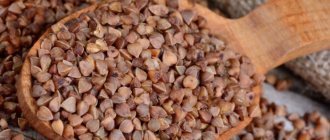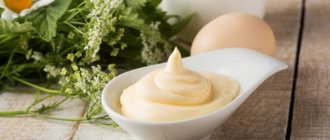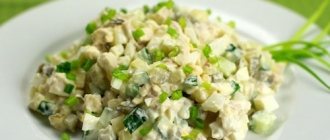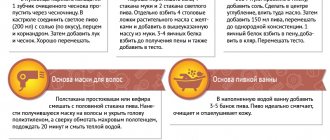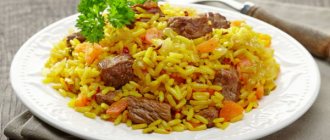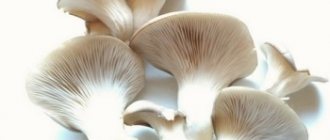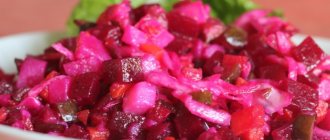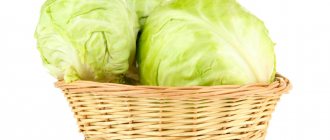Recipes and calorie content of some onion dishes
Due to the fact that onions themselves are low in calories, they can be used in all dishes.
But when frying, onions become less dietary. Therefore, it is unlikely that potatoes with mushrooms and fried onions can be called low-calorie food. Dietary dishes with onions are mainly soups and salads. For weight loss, an onion diet was created, during which you can lose 5 kg in a week.
Onion soup recipe for weight loss with photo
This soup is one of the lowest calorie dishes containing onions. It will require:
- chicken broth or clean water (1.5 liters);
- cabbage (400-500 grams);
- celery (120 grams);
- fresh onions (5 pieces);
- salt (1/2 teaspoon)
Cut the onion into half rings, finely chop the cabbage, cut the celery into small cubes. Place everything in a saucepan, add broth or water. After boiling, reduce heat and cook for 20-30 minutes. Salt at the very end. The calorie content of this soup per 100 grams is only 23 kcal.
Leek soup recipe
Leeks are one of the lowest calorie types of onions. For dietary soup with it we will need:
- water (3.5 liters);
- young potatoes (4 pieces);
- medium carrots (3 pieces);
- parsley root (2 pieces);
- leek (600 grams);
- butter (3 teaspoons).
Place carrots and parsley root in water, cook until tender. After straining, add diced potatoes and thinly sliced leeks to the resulting liquid. The soup will be ready when the potatoes and onions are boiled. Add butter before serving.
It turns out delicious, and most importantly healthy. 100 grams of soup contain 13 kcal.
Green onion salad
This is a familiar cucumber-tomato salad; to prepare it you need:
- medium tomatoes (150 grams);
- medium cucumbers (150 grams);
- fresh green onions (60 grams);
- low-fat sour cream (1 tablespoon).
Everything is very simple. We cut tomatoes and cucumbers into small cubes, green onions into rings. Put everything in a salad bowl, add sour cream and mix.
The salad is really easy to prepare, nutritious and refreshing in hot weather, and there are very few calories: only 44.5 kcal per 100 grams of dish.
Greek salad
Greek salad with red onion is a favorite for many people. To prepare it you will need:
- medium tomatoes (4 pieces);
- medium cucumbers (3 pieces);
- small red onion (1 piece);
- olives (9 pieces);
- feta cheese (70 grams);
- olive oil (10 grams).
Cut tomatoes into quarters, cucumbers into slices, onions into half rings. Mix everything with the addition of olive oil. Cut the cheese into small cubes. When serving, garnish with olives and cheese.
The salad turns out to be low-calorie: 100 grams of salad accounts for 50.3 kcal.
Salad with egg and onion
The simplest salad, tasty and satisfying. It only requires three ingredients:
- large chicken eggs (5 pieces);
- fresh green onions (200 grams);
- low-fat sour cream (4 tablespoons).
Boil the eggs hard, peel and cut into cubes. Cut the onion into rings. Place in one container, add sour cream and mix.
100 grams of salad contain 177 kilocalories.
What can you cook?
Beer.
calorie content 1 liter, 100 grams, proteins, fats, carbohydrates, composition Every housewife will probably remember a couple of dishes where onions will definitely be present. There are several recipe options for onion soup with croutons and cheese. Fans of French cuisine will surely like it.
And in almost any first course there are fried pieces of onion. It is added to many salads and meat snacks. Vegetarians treat themselves to onion cutlets.
But few people know that pies, cakes and even marmalade are made from onions. To do this, the onions are pickled and then caramelized. True, such desserts should be eaten on the day of preparation, because later their taste changes greatly.
Red onion
Red onion as a variety is becoming increasingly popular. This can be explained by its increased juiciness and sweetish taste.
It is also important that it contains twice as many antioxidants as its light-headed relatives . In addition, red onions look very impressive in dishes.
The calorie content of red onions is almost the same as that of regular white onions - approximately 42 kcal.
By introducing onion dishes into your daily diet, you will not only enrich your body with useful substances and minerals, but also help it set a course for healthy, low-calorie, and, at the same time, healthy recovery.
Calorie content of green onions
Beef liver. calorie content per 100 grams, composition, proteins-fats-carbohydrates. benefits and harms of dieting
The calorie content in green onions is perhaps the lowest - 20 kcal per hundred grams of product. Also, the calorie content of green onions includes proteins, fats and carbohydrates in minimal quantities. Therefore, those people who are on any diet, having found out how many calories are in green onions, can include it in their diet.
In addition to the low calorie content of green onions, they are very beneficial for the human body. Its beneficial properties are no less useful and diverse than the beneficial properties of onions.
Green onions are best known for their preventive properties in the fight against colds. It improves immunity and strengthens the human body. Green onions help to cope with stressful situations and restore lost pep.
Green onions contain a lot of zinc, which has a beneficial effect on reproductive functions. It also includes vitamin C and calcium, strengthens the cardiovascular system, and maintains blood pressure within normal limits.
If you eat this product in moderation, it helps improve digestion and cleanses the body of harmful substances. Green onions are added to various dishes, as they increase appetite and provoke the secretion of gastric juice.
As noted above, the caloric content of onions is low, only 20 kcal per hundred grams of product, so it not only adds taste to dishes familiar to everyone, but also cannot harm the figure.
It is preferable to consume green onions fresh, as an addition to vitamin-rich salads, since heat treatment will leave less of the beneficial substances contained in onions. In addition, green onions have an antiseptic effect and destroy many known pathogenic bacteria.
Chemical composition of onions
The content of nutrients in onions depends on the type, climatic conditions and place of growth.
But the vitamins, macro and microelements contained in different onion varieties will be similar:
| Vitamins | Macronutrients | Microelements |
| В1, В2, В5, В6, В9, РР, С, Е, Н, A | Sulfur, calcium, chlorine, magnesium, phosphorus, sodium, potassium. | Rubidium, iron, nickel, zinc, aluminum, iodine, cobalt, copper, boron, manganese, fluorine, chromium. |
The vegetable is widely used in home medicine for colds. The antiviral effect is achieved thanks to the phytoncides contained in onions - special substances, the chemical composition of which has not been fully studied.
Chemical composition: KBJU (calories, proteins, fats, carbohydrates)
“umalat” (Adyghe cheese): composition, calorie content, reviews, recipes
Let's consider what is contained in the vegetable - what is its energy, nutritional, vitamin value, what mineral elements it contains.
How many calories are in onions: raw, boiled, sautéed, baked?
The energy value of the product varies depending on the method of its preparation:
- dried (dehydrogenated) in the form of flakes - 349 kcal;
- dried shredded - 208 kcal;
- calorie content of fresh (raw) onions - 42 kcal;
- fried (passivated) - 123 kcal;
- baked onions without oil - 47 kcal;
- pickled - 82 kcal;
- boiled calorie content - from 40 to 44 kcal;
- deep fried - 239 kcal.
Which cooking method has the most calories in a vegetable?
The next most calorie-rich vegetables are dried vegetables, cut into rings or half rings, deep-fried and sautéed. Baked, boiled and raw are the lowest calorie options.
Calorie content of red and white onions: is there a difference?
Yes, there is a difference. This is not to say that it is significant. How many kilocalories a particular variety contains depends on the difference in the content of proteins, carbohydrates and other substances. Regular onions contain 42-44 kcal per 100 g, and sweet varieties - 32-35 kcal. At the same time, the white variety, the purple one, and the red one can be sweet.
Nutritional value: BJU per 100 grams
The nutrient content of the product is presented in the table.
The BJU of pickled onions is indicated for a vegetable cooked with vinegar, vegetable oil, sugar, salt and spices. The “Fried” column shows indicators for the sautéed product. If deep frying is carried out, the protein content in the product will be 4.8 g, carbohydrates - 25.3 g, fat - 14 g, dietary fiber - 9.4 g.
What vitamins do onions contain?
If we take into account the percentage of the body’s daily need for vitamins, then the vegetable in this regard contains the most ascorbic acid - it is found in large quantities in the product. The following vitamins are found in onions: The chemical composition of red onions differs little from white ones in terms of vitamins.
The only difference is in the composition of the husk, which is used in folk medicine - the white one has virtually no vitamin C
The chemical composition of red onions differs little from white ones in terms of vitamins. The only difference is in the composition of the husk, which is used in folk medicine - the white one has virtually no vitamin C.
Macronutrients
The vegetable contains a lot of potassium, phosphorus, and sulfur. The detailed macronutrient composition can be found in the table.
Of the macroelements, blue and red bulbs contain more sulfur compared to white ones. This makes it more useful for cleansing the blood, removing cholesterol, and hematopoietic processes. This element is also necessary for the synthesis of cysteine - this amino acid is important for the renewal of elastin and collagen.
Microelements
Let's see which microelements are the leading content in the product.
The vegetable also contains aluminum, boron, nickel, and rubidium. Red varieties of onions contain more trace elements than chromium. This element helps lower blood glucose.
Sugar content per 100 g
Simple carbohydrates of onions are represented by mono- and disaccharides in the amount of 8.2-8.8 g, which include:
- sucrose - 6.5 g;
- glucose (dextrose) - 1.3 g;
- fructose - 1.1 g.
These are averages and may vary slightly depending on how sweet the variety is.
What other substances does onion contain?
Onions contain a lot of vitamins and microelements. But besides them and nutrients, the vegetable contains valuable biologically active compounds:
- Phytoncides are volatile substances that have a detrimental effect on bacteria, protozoa and viruses.
- The flavonoid quercetin is not an essential nutrient, but has a pronounced anti-inflammatory and antioxidant effect.
- Allicin is one of the main active substances in garlic, but is also found in onions; has strong antibacterial activity, which it retains in both gastric juice and blood.
- Anthocyanins - compounds from the group of glycosides, are present in purple and red onions and their peels, causing their color; reduce inflammation and oxidation processes in cells (that is, they are antioxidants).
- Organic acids - malic, citric and others.
Micro- and macroelements in onions
Onions contain the following elements: Mono- and disaccharides, Ash, Starch, Water, Organic acids, Dietary fiber, Sodium, Potassium, Phosphorus, Magnesium, Calcium, Sulfur, Copper, Boron, Aluminum, Iodine, Manganese, Chromium, Fluorine, Cobalt , Nickel, Rubidium, Zinc, Iron, Chlorine.
| Mono- and disaccharides, g. | 8,1 |
| Zola, Mr. | 1 |
| Starch, Mr. | 0,1 |
| Water, city | 86 |
| Organic acids, g. | 0,2 |
| Dietary fiber, g. | 3 |
| Sodium, mg | 4 |
| Potassium, mg | 175 |
| Phosphorus, mg | 58 |
| Magnesium, mg | 14 |
| Calcium, mg | 31 |
| Sulfur, mg | 65 |
| Copper, µg | 85 |
| Boron, µg | 200 |
| Aluminum, µg | 400 |
| Iodine, mcg | 3 |
| Manganese, mg | 0,23 |
| Chromium, µg | 2 |
| Fluorine, mcg | 31 |
| Cobalt, µg | 5 |
| Nickel, µg | 3 |
| Rubidium, mcg | 476 |
| Zinc, mg | 0,85 |
| Iron, mg | 0,8 |
| Chlorine, mg | 25 |
5
For men
Benefits of regular consumption of onions for men:
- improvement of blood flow in the pelvic organs;
- improvement of potency;
- increased libido;
- stimulation of sperm production;
- normalization of hormonal levels.
You can increase the benefits of the product if you consume it together with herbs, vegetables, and garlic.
How many calories are in fried onions?
Onions are one of the most commonly found vegetables in the world. It has many beneficial properties, such as maintaining blood sugar balance and helping those wishing to lose weight. Many diets use onions both as an additive to main dishes and as a main ingredient.
Useful properties and calorie content of onions
The most popular and in demand, both in the kitchen and in the home pharmacy, is onion, which has many beneficial properties and gives any dish a unique taste and aroma.
Speaking about how many calories are in onions, first of all, it is worth talking about its medicinal properties, and it is they that are used in folk medicine most often. Phytoncides, contained in large quantities in onions, deserve special attention.
This allows it to be used for the prevention and treatment of infectious and colds.
Onions also contain a large amount of ascorbic acid (vitamin C), which strengthens the immune system and gives the body additional protection.
It should also be noted that onions help the functioning of the digestive organs, stimulating the production of gastric juice and increasing appetite due to the essential oils present.
However, if you have problems with high acidity, it is better to refrain from excessive consumption of onions.
Being the healthiest of all types of onions, onions have a higher calorie content, which, however, does not play a big role and does not lead to excess weight.
Knowing how many calories are in onions, and 100 grams of the product contains only 43 calories, you can safely include it even in a diet for weight loss. Struggling with extra pounds, many ask themselves the question of how many calories are in fried onions.
It has been proven that the number of calories in boiled onions is reduced to 37 kcal, while fried onions already contain 250 kcal per 100 grams of product, so it is better not to eat fried onions as a separate dish.
When talking about onions, we cannot keep silent about white onions, which are especially popular in European cuisine and the French even make the famous onion soup from it.
In this indicator, it can be compared with white onions, since 100 grams of white onions contain only 40 kcal, which allows us to call white onions a dietary product.
Harm of fried onions
However, it should be noted that fried onions are harmful, because, like most fried foods, they do not have any benefits for the liver. In addition, during heat treatment, onions partially lose their beneficial substances, of which, by the way, the finished product still contains a lot. The calorie content of fried onions is approximately 251 kcal.
How many calories are in different types of onions?
At the moment there are many types of onions.
They all have different calorie content, taste, color, smell and are used for different types of dishes. Onions can be eaten raw, boiled, fried, or stewed. If it is green onions, then it can be consumed either fresh or dried. Depending on what type of onion it is and how it is prepared, its calorie content also changes.
The most high-calorie and unhealthy dishes were exposed to high temperatures during preparation.
Calorie content of different types of onions per 100 g
- Fresh green onions – 19 kcal / 100 g
- Leek - 33 kcal / 100 g
- Boiled onions – 37 kcal / 100 g
- Stewed onions – 39 kcal / 100 g
- Fresh onions – 41 kcal / 100 g
- White onion - 41 kcal / 100 g
- Red onion - 41 kcal / 100 g
- Yalta onion - 42 kcal / 100 g
- Shallots – 72 kcal / 100 g
- Dried green onions - 219 kcal / 100 g
- Fried onions – 251 kcal / 100 g
- Onions fried in batter - 329 kcal / 100 g
Leek calories
Relatively recently, leeks appeared in our kitchen, attracting attention with their appearance. Those who want to know how many calories are in leeks will find useful information about what beneficial properties they have
Research shows that leeks contain vitamin C, the amount of which it surpasses onions and green onions, and the amount of vitamin A needed for the eyes, it surpasses even carrots. Leeks have a positive effect on the human immune and cardiovascular system, and they are very filling, although their calorie content is only 35 kcal per 100 grams.
Calorie content
The energy value of onions differs depending on the heat treatment. In its raw form, it is used in salads, and as a fry - for soups. It is added to almost all dishes.
The first mention of the onion was more than five thousand years ago
Raw
Fresh onions have the maximum concentration of essential oils and vitamins. The calorie content of the vegetable in its raw form is 42.6 kcal per 100 grams of product. It is a mandatory ingredient for various salads and is used as an addition to meat, fresh or marinated.
The vegetable is useful for the prevention and elimination of diseases:
- for viral and bacterial infections;
- with urolithiasis;
- for problems with potency;
- to improve digestion;
- to speed up metabolism.
The number of calories in onions increases when baked or fried.
Boiled
Kbju in the boiled product: 37.8 kcal, 1.4, 0.01, 7.84 grams, respectively. There are 51.8 calories in 100 grams of stewed onions . Boiled and stewed onions can be consumed by those people for whom the raw product is contraindicated.
After heat treatment, the bitterness disappears, the vegetable acquires a delicate consistency. When boiled, it is better digested and does not irritate the mucous membranes.
Boiled onions reduce the vitamin C content
It is indicated for people with diseases of the gastrointestinal tract.
During pregnancy and breastfeeding, a woman may have a question about how eating turnips will affect the baby. And also, what vitamins are contained in boiled and stewed onions. Pregnant women can also eat fresh product, but in reasonable quantities so as not to provoke heartburn.
In boiled onions, not only the calorie content decreases, but also some vitamins and minerals disappear or are reduced. For example, the amount of vitamin C decreases: in a boiled onion, its specific gravity per 100 grams is 5 mg.
baked
A baked vegetable is very useful. But in this case, the number of calories in onions reaches 110. It is often used in folk medicine as a remedy for a variety of diseases:
- from pimples and acne;
- with furunculosis;
- from calluses;
- from hemorrhoids;
- from parasites;
- for constipation.
To strengthen the immune system, it is enough to eat one baked onion a day.
Bake the onion in the oven or microwave. To do this, you need to take bulbs of the same size. You can choose any variety: yellow, red or white. The vegetable is cleaned of contaminants, but there is no need to peel off the husks. Each onion is wrapped in foil, placed on a baking sheet and baked at 180 degrees for about 15 minutes. If after some time the onion turns golden, it is ready.
You can also prepare many delicious and beautiful dishes with baked onions:
Recipe from Yulia Vysotskaya “Chicken with baked pumpkin, onions and walnuts”
Baked onions can be consumed by people suffering from obesity, diabetes, atherosclerosis, and hypertension. The recommended dosage is two bulbs per day. To prevent iron deficiency and strengthen the immune system, you can use one onion per day.
Fried
The highest calorie content is found in fried onions - 174.1 kcal.
It is used as a fry or sautéed with carrots and other vegetables for soups and side dishes. It retains vitamins and minerals, but loses their concentration. During frying, the onion loses its pungency and pungent odor. It can be seasoned and salted. Then it will reveal its sweetish taste and retain its tenderness.
Onion rings are very high in calories, 100 grams contain more than 400 kcal
In battered and breaded onion rings, the calorie content is 411 kilocalories, and the amount of bju is 4.95, 16.90, and 46.85 grams, respectively. It is better to reduce their use.
The benefits of onions
Each of us has heard about the great benefits of onions since childhood. The main useful properties of the product are:
- the product has an anti-inflammatory and bactericidal effect against colds and ARVI;
- onions are characterized by a high content of flavonoids, which prevent the formation of cancer cells;
Interesting: Calorie content of milk powder
- Numerous studies have shown that eating onions is an effective way to stimulate male potency. In the Middle Ages, due to its stimulating effect, the product was banned in all monasteries;
- Eating onions daily speeds up metabolism and ensures effective cleansing of the body from toxins;
- inflammatory bowel diseases have been treated since ancient times with the help of onion juice;
- onions are an excellent diuretic and reduce cholesterol levels in the blood;
- in combination with honey, the vegetable is indicated for bronchitis;
- With the help of onion infusion you can quickly get rid of helminths.
We can talk a lot more about the benefits of onions. However, it is already clear from the list presented above that this product must be present in the diet.
History of onions
Many ancient populations believed that eating onions helped treat diseases and should be part of a healing diet. Records show that onions have been used throughout the world as a valuable medicinal and food source for thousands of years. Although there is no conclusive evidence as to where it first appeared, there is evidence showing that this vegetable was used more than 5,000 years ago in parts of Iran and West Pakistan.
Onions may be one of the earliest crops to be grown because they were less perishable than other foods of the time. It was popular because it transported well, was easy to grow year-round, and grew well in a variety of climates and soil types. Onions could also be dried and preserved, making them a valuable source of nutrients during times of famine.
Some records show that onions grew in parts of China, India and Egypt around 3500 BC. In Egypt, the bow was even considered an object of worship and symbolized eternity due to its ring-shaped structure. Images of onions can even be found on the interior walls of ancient Egyptian pyramids and tombs! Onions were also consumed by the Israelites and were mentioned as one of the biblical foods, along with cucumbers, melons, leeks and garlic.
Currently, the largest onion producers in the world are China, India and the USA.
Benefits and harms
Beneficial properties of onions for the body:
- active against pathogenic microbes: viruses, bacteria, fungi;
- increases appetite;
- removes excess cholesterol, cleansing blood vessels, thereby providing a preventive effect against atherosclerosis;
- has an anti-inflammatory effect;
- has a detrimental effect on intestinal parasites;
- replenishes the body with vitamins, macro- and microelements, providing a general strengthening effect.
Onions are used for colds, coughs, flu, headaches, varicose veins, high blood pressure, prostatitis, stomatitis, bleeding gums and many other diseases.
The harm of the product consists of a possible exacerbation of diseases of the kidneys, liver, gastrointestinal tract and heart, increased stomach acidity, lethargy, drowsiness, diarrhea, bloating, and allergic reactions.
For men
Valuable properties of the vegetable for men's health:
- increases libido, enhancing sexual desire;
- stimulates testosterone production;
- helps in the treatment and prevention of prostatitis, impotence, prostate adenoma;
- increases sperm volume and quality.
The vegetable is also an effective remedy for the prevention and treatment of hair loss, as it increases blood flow to the scalp and strengthens the hair follicles.
For women
Benefits of vegetables for women's health:
- normalizes the menstrual cycle, helps in the absence of menstruation;
- has an anti-edematous effect;
- strengthens hair, improves skin condition;
- good for reproductive health in general thanks to zinc and vitamins.
Note: For menstruation, in the absence of pathological reasons, drink an infusion of onion peels, brewing 2 tbsp. l. raw materials 300 ml boiling water for an hour. This volume is drunk in three doses the day before meals - 100 ml each.
For children
Due to the content of phytoncides, vitamins, and mineral components, onions are useful for children as a general tonic and as an addition to the treatment of coughs and acute respiratory infections. For therapeutic purposes, the vegetable can be used no earlier than the child turns 3 years old and after prior consultation with a doctor.
The low glycemic index and calorie content of onions, the presence of vitamins, mineral elements, and biologically active substances (antioxidants, flavonoids) make the vegetable very beneficial for human health. Red and purple varieties contain in their chemical. contains anthocyanins, more chromium, sulfur and quercetin, which is more useful for diabetics, cleansing blood vessels, preventing colds, flu and atherosclerosis.
Read further:
The richer you are, the happier you are: chemical composition and calorie content of onions per 100 g
Chemical composition, calorie content and properties of dill. What do greens contain and how are they beneficial?
Description of the chemical composition of black radish, including calorie content: benefits and contraindications for use
Everything about the chemical composition of white cabbage, including calorie content and nutritional value
What benefits peppermint contains: chemical composition and calorie content of the plant
Onions in recipes:
Cabbage and breast salad 76.61 kcal/100 g. Recipe
Pangasius baked with onions 83.13 kcal/100 g. Recipe for pangasius baked with onions
Zucchini cutlets 89.45 kcal/100 g. Recipe for making zucchini cutlets
Chicken zrazy with egg 140.22 kcal/100 g. Recipe for chicken zrazy with egg
Salad “Generous Autumn” 73.94 kcal/100 g. Recipe for salad “Generous Autumn”
Mushroom and squid salad 69.27 kcal/100 g. Recipe for mushroom and squid salad
Mushroom solyanka 27.39 kcal/100 g. Recipe for mushroom solyanka
Pumpkin puree soup “Carriage for Cinderella” 28.4 kcal/100 g. Recipe for pumpkin puree soup “Carriage for Cinderella”
Kababi 160.23 kcal/100 g. Kababi recipe
Stuffed peppers 65.76 kcal/100 g. Recipe for stuffed peppers
Squid with cheese and mushroom filling 133.28 kcal/100 g. Recipe for squid with cheese and mushroom filling
Fish cutlets with cauliflower 117.81 kcal/100 g. Recipe for making fish cutlets with cauliflower
Salad with mussels 111.16 kcal/100 g. Recipe for salad with mussels
Pink salmon baked in sour cream and mushroom sauce 100 kcal/100 g. Recipe for pink salmon baked in sour cream and mushroom sauce
Vegetable stew with red beans 52.7 kcal/100 g. Recipe for vegetable stew with red beans
Chicken pancakes 121.6 kcal/100 g. Chicken pancakes recipe
Soup with chicken and dumplings 53.21 kcal/100 g. Recipe for soup with chicken and dumplings
Rice with ginger 89.46 kcal/100 g. Recipe for rice with ginger
Celery soup 11.13 kcal/100 g. Celery soup recipe
Chicken with rice and olives in a pot 111.93 kcal/100 g. Recipe for chicken with rice and olives in a pot
Tomato soup with squid 30.05 kcal/100 g. Recipe for tomato soup with squid
Baked potatoes with herbs 118.22 kcal/100 g. Recipe for baked potatoes with herbs
White fish fritters 112.16 kcal/100 g. Recipe for white fish fritters
Vegetable puree soup with fried mushrooms 68.92 kcal/100 g. Recipe for vegetable puree soup with fried mushrooms
Chinese salad 93.78 kcal/100 g. Chinese salad recipe
Rice casserole with mushrooms 119.34 kcal/100 g. Recipe for rice casserole with mushrooms
Moussaka with eggplant 37.28 kcal/100 g. Recipe for making moussaka with eggplant
Celery soup for weight loss 29.99 kcal/100 g. Recipe for making celery soup for weight loss
Chicken liver roll 124.06 kcal/100 g. Chicken liver roll recipe
Aromatic tomato and bean soup 155.77 kcal/100 g. Recipe for making aromatic tomato and bean soup
Calorie content, BJU and glycemic index of onions per 100 g
Fresh vegetables have a low glycemic index (GI), it does not provoke a sharp rise in blood sugar, and therefore is not contraindicated for people with diabetes. The energy value of the product and GI vary depending on the method of its preparation:
| Method of preparation and type of onion | Calorie content | Proteins, g | Fats, g | Carbohydrates, g | GI |
| fresh | 42 kcal | 1,1 | 0,1 | 9 | 10 |
| boiled | 42 kcal | 1,36 | 0,19 | 8,75 | 15 |
| fried | 258 kcal | 3,2 | 14 | 31 | 98 |
| stew | 48.5 kcal | 1.35 | 0.05 | 7.9 | 15 |
| baked | 36.6 kcal | 1,3 | 1,78 | 8,4 | 15 |
| green onions | 32 kcal | 1,8 | 0,2 | 7 | 39 |
| leek | 61 kcal | 1,5 | 0,3 | 14 | 15 |
| shallot | 72 kcal | 2,5 | 0,1 | 17 | 32 |
| onion | 41 kcal | 1,4 | 0,2 | 8,2 | 10 |
It is worth keeping in mind that when adding salt to onions, its calorie content increases by 2-3 kcal. Other additives, spices, sauces, oils, etc. also play a role. In the same way, the glycemic index changes when cooked - for example, caramelizing onions in sugar will significantly increase the GI.
Is there a difference in calories between red and white onions?
It cannot be said that it is the color of the bulbs that affects its nutritional value. Also, the number of calories depends on the content of proteins, fats and carbohydrates in the vegetable. The calorie content of classic onions is 42 kcal, and sweet varieties - 32-35 kcal. Any onion can be sweet, regardless of color.
Calorie content! Fresh onions. Chemical composition and nutritional value.
Nutritional value and chemical composition of “!Fresh onions”.
The table shows the nutritional content (calories, proteins, fats, carbohydrates, vitamins and minerals) per 100 grams of edible portion.
| Nutrient | Quantity | Norm** | % of the norm in 100 g | % of the norm in 100 kcal | 100% normal |
| Calorie content | 41 kcal | 1684 kcal | 2.4% | 5.9% | 4107 g |
| Squirrels | 1.4 g | 76 g | 1.8% | 4.4% | 5429 g |
| Fats | 0.2 g | 56 g | 0.4% | 1% | 28000 g |
| Carbohydrates | 8.2 g | 219 g | 3.7% | 9% | 2671 g |
| Organic acids | 0.2 g | ~ | |||
| Alimentary fiber | 3 g | 20 g | 15% | 36.6% | 667 g |
| Water | 86 g | 2273 g | 3.8% | 9.3% | 2643 g |
| Ash | 1 g | ~ | |||
| Vitamins | |||||
| Vitamin B1, thiamine | 0.05 mg | 1.5 mg | 3.3% | 8% | 3000 g |
| Vitamin B2, riboflavin | 0.02 mg | 1.8 mg | 1.1% | 2.7% | 9000 g |
| Vitamin B5, pantothenic | 0.1 mg | 5 mg | 2% | 4.9% | 5000 g |
| Vitamin B6, pyridoxine | 0.12 mg | 2 mg | 6% | 14.6% | 1667 g |
| Vitamin B9, folates | 9 mcg | 400 mcg | 2.3% | 5.6% | 4444 g |
| Vitamin C, ascorbic acid | 10 mg | 90 mg | 11.1% | 27.1% | 900 g |
| Vitamin E, alpha tocopherol, TE | 0.2 mg | 15 mg | 1.3% | 3.2% | 7500 g |
| Vitamin H, biotin | 0.9 mcg | 50 mcg | 1.8% | 4.4% | 5556 g |
| Vitamin RR, NE | 0.5 mg | 20 mg | 2.5% | 6.1% | 4000 g |
| Niacin | 0.2 mg | ~ | |||
| Macronutrients | |||||
| Potassium, K | 175 mg | 2500 mg | 7% | 17.1% | 1429 g |
| Calcium, Ca | 31 mg | 1000 mg | 3.1% | 7.6% | 3226 g |
| Magnesium, Mg | 14 mg | 400 mg | 3.5% | 8.5% | 2857 g |
| Sodium, Na | 4 mg | 1300 mg | 0.3% | 0.7% | 32500 g |
| Sera, S | 65 mg | 1000 mg | 6.5% | 15.9% | 1538 g |
| Phosphorus, Ph | 58 mg | 800 mg | 7.3% | 17.8% | 1379 g |
| Chlorine, Cl | 25 mg | 2300 mg | 1.1% | 2.7% | 9200 g |
| Microelements | |||||
| Aluminium, Al | 400 mcg | ~ | |||
| Bor, B | 200 mcg | ~ | |||
| Iron, Fe | 0.8 mg | 18 mg | 4.4% | 10.7% | 2250 g |
| Yod, I | 3 mcg | 150 mcg | 2% | 4.9% | 5000 g |
| Cobalt, Co | 5 mcg | 10 mcg | 50% | 122% | 200 g |
| Manganese, Mn | 0.23 mg | 2 mg | 11.5% | 28% | 870 g |
| Copper, Cu | 90 mcg | 1000 mcg | 9% | 22% | 1111 g |
| Nickel, Ni | 3 mcg | ~ | |||
| Rubidium, Rb | 476 mcg | ~ | |||
| Fluorine, F | 31 mcg | 4000 mcg | 0.8% | 2% | 12903 g |
| Chromium, Cr | 2 mcg | 50 mcg | 4% | 9.8% | 2500 g |
| Zinc, Zn | 0.85 mg | 12 mg | 7.1% | 17.3% | 1412 g |
| Digestible carbohydrates | |||||
| Starch and dextrins | 0.1 g | ~ | |||
| Mono- and disaccharides (sugars) | 8.1 g | max 100 g | |||
| Glucose (dextrose) | 1.3 g | ~ | |||
| Sucrose | 6.5 g | ~ | |||
| Fructose | 1.2 g | ~ | |||
| Essential amino acids | 0.286 g | ~ | |||
| Arginine* | 0.16 g | ~ | |||
| Valin | 0.025 g | ~ | |||
| Histidine* | 0.014 g | ~ | |||
| Isoleucine | 0.04 g | ~ | |||
| Leucine | 0.05 g | ~ | |||
| Lysine | 0.06 g | ~ | |||
| Methionine | 0.01 g | ~ | |||
| Methionine + Cysteine | 0.02 g | ~ | |||
| Threonine | 0.04 g | ~ | |||
| Tryptophan | 0.02 g | ~ | |||
| Phenylalanine | 0.041 g | ~ | |||
| Phenylalanine+Tyrosine | 0.07 g | ~ | |||
| Nonessential amino acids | 0.663 g | ~ | |||
| Alanin | 0.058 g | ~ | |||
| Aspartic acid | 0.07 g | ~ | |||
| Glycine | 0.041 g | ~ | |||
| Glutamic acid | 0.22 g | ~ | |||
| Proline | 0.03 g | ~ | |||
| Serin | 0.027 g | ~ | |||
| Tyrosine | 0.03 g | ~ | |||
| Cysteine | 0.013 g | ~ |
The energy value of fresh onions is 41 kcal.
Primary Source: Created in the application by the user. Read more.
** This table shows the average levels of vitamins and minerals for an adult. If you want to know the norms taking into account your gender, age and other factors, then use the “My Healthy Diet” application.
Cereals and legumes
Cereals supply the complex carbohydrates the body needs for a balanced diet.
Consuming slow-acting carbohydrates prevents a sharp rise in blood glucose and keeps you full for several hours. In addition to carbohydrates, legumes contain a large amount of vegetable protein. Calorie content of cereals and legumes per hundred grams:
| Cereals | Calorie content per 100 g of dry product | Calorie content per 100 g of prepared product |
| Buckwheat | 346 | Porridge on water: 132 |
| White rice | 330 | Porridge with water: 97 Porridge with milk: 116 |
| Brown rice | 330 | Porridge on water: 97 |
| Lentils | 310 | Boiled: 111 |
| Beans | 328 | Boiled: 123 |
| Millet | 351 | Porridge with water: 100 Porridge with milk: 135 |
| Semolina | 340 | Porridge with milk: 98 |
| Pearl barley | 342 | Porridge on water: 106 |
| Oats | 374 | Porridge with water: 88 Porridge with milk: 102 |
| Cereals | 365 | Porridge with water: 76 Porridge with milk: 100 |
Harm and contraindications for use
Harmful properties of green onions:
- specific odor from the mouth after consuming the product;
- irritation of the gastric mucosa;
- increased acidity of gastric juice;
- heartburn and belching;
- reducing the effect of blood thinners.
Contraindications:
- inflammatory liver diseases (hepatitis, cirrhosis);
- stomach ulcer, gastritis;
- bacterial diseases of the gastrointestinal tract;
- high blood pressure;
- bronchial asthma;
- allergy;
- exacerbation of obstructive pulmonary pathologies;
- pancreatitis.
In the remission stage of inflammatory diseases of the pancreas and gastrointestinal tract, the product is introduced into the diet gradually and only after consultation with the attending physician. Green feathers are thermally treated to reduce the negative impact on the body.
The ban on eating onions during inflammatory processes in the pancreas is due to the presence of aggressive essential oils in the product, which promote increased secretion of the organ. Fiber, which is part of green feathers, increases gas formation, causing painful and unpleasant sensations.
Calorie table for different types of onions
The ancient Greeks used the plant as a medicinal drug and considered it food for the poor. This was explained by bad breath after consumption, but today the vegetable is very popular, widely used in cooking for preparing first courses, side dishes, gravy, meat, fish, and even confectionery. The vegetable is used boiled, fried, dried, pickled, stewed.
Of course, the calorie content of the product changes, that is, it depends on the method of preparation. Below is a table of calorie content per 100 grams of boiled, dried, fried, pickled onions.
2
Chemical composition and benefits of fresh onions
Fresh onions contain:
- vitamins B, C;
- essential oils;
- zinc;
- fluorine;
- iodine;
- iron;
- copper;
- cobalt;
- nickel;
- flavonoids;
- vegetable acids.
Beneficial properties of raw vegetables:
- anti-inflammatory;
- bactericidal;
- anti-cold;
- anticancer;
- metabolic;
- diuretic.
Regular consumption of onions increases male potency and increases sperm quality. Vegetable juice is used to treat bronchitis, sinusitis, ARVI and acute respiratory infections. It helps cure intestinal diseases and reduce blood cholesterol levels. Onion infusion effectively fights worms.
Composition and calorie content of cucumber, benefits and harm to the body
Features of use
It is worth noting that regular consumption of onions has a positive effect on the entire body, it strengthens the immune system and gives vitality.
For men
Constant consumption of onions by males increases potency, enhances libido, and has a good effect on the quality of semen. This product is also an excellent prevention against prostate adenoma. This vegetable is often included in the diet for many diseases, as it has an anti-inflammatory effect, is a diuretic and prevents the appearance of tumor formations.
This product not only inhibits the appearance and development of adenoma, but also improves overall well-being by enhancing the immune system. Onion peels are good for certain symptoms of benign prostatic hyperplasia (BPH). A decoction of it reduces pain when taken regularly. At the same time, take a freshly prepared decoction. Moreover, the best results are obtained by mixing onions with honey or other bee products.
For women
Onions are recommended to be included in the menu for women who want to conceive a child, since this product contains enough zinc, which helps normalize reproductive function. The vegetable also contains a lot of iron, so it must be consumed when hemoglobin is low. This product is relevant in the diet of pregnant and lactating women (boiled), since it contains vitamin B9, which is required for the normal development of the fetus.
Read also: Flushing the heating system in a private house
The vitamins and antioxidants contained in this vegetable contribute not only to better health, but also to a better appearance and promote weight loss. Women use this vegetable for cosmetic purposes. You can make a face mask from it at home. To do this, use the product or its juice in raw form or in combination with other products. Onion juice without additives smoothes and brightens the skin and is an excellent remedy for skin pigmentation.
This product perfectly promotes hair strengthening and growth, helps with hair loss and fights dandruff. A decoction of onion peels gives the hair a golden hue, and also nourishes the hair and makes it shiny. The only drawback is that when used for cosmetic purposes, this vegetable gives off a specific smell. But after a while it still dissipates, so for the sake of getting a good result, you can ignore it.
For children
Nutritionists recommend including this vegetable in children's diets. It improves appetite and the digestive process, strengthens bones and blood vessels. This product is simply a storehouse of vitamins for a child’s body; it contains vitamins C and E, which are necessary at this age. Onion juice with warm milk helps children fall asleep soundly, and all dishes using raw vegetables are an excellent preventive measure against worms without side effects.
However, children should be introduced to this vegetable by first giving them a boiled product. Boiled vegetables can be given to babies from 8 months. It is usually given in pureed vegetable soups. It goes well with potatoes, pumpkin, zucchini, and carrots. You can add a small amount to your baby’s first puree soup – a quarter of a small onion. The raw product can be introduced into a child’s diet no earlier than three years of age. It is best added to salads.
How to eat onions
Onions are most useful in their raw form; during heat treatment they lose a large amount of vitamins.
The onion cooking time is only 10 minutes, but if you use ready-made frying, the time is reduced to 5 minutes.
The whole onion is boiled if it is necessary to eliminate the unpleasant aftertaste of the meat; in this case, it is pulled out at the end of cooking, but during the cooking process the onion manages to release all its beneficial substances.
To avoid tearing while peeling and slicing onions, use one of the following methods:
- keep the onion in the refrigerator before slicing;
- wet the knife with cold water while slicing;
- use special safety glasses.
Bulb onions
Onions are a herbaceous perennial of the Onion family, one of the most common vegetable crops. Mediterranean countries, China and Iran used onions for food long before our era; in Russia, the spread of onions began in the 12th century from the Roman Empire.
Onions, depending on the variety, have a round, slightly elongated or flattened scaly bulb, white, purple or golden in color, the outer shell is dry and brittle, inside there are fleshy, juicy scales of white or slightly pinkish color. Onions have a pungent taste and a rather pungent odor.
Composition and beneficial properties of onions
Onions contain a large amount of vitamin C, an antioxidant necessary for the prevention of colds, strengthening the immune system and fighting viruses. A special substance was discovered in onions - the flavonoid quercetin, which promotes the breakdown of fats and slows down the growth of cancer cells. The bulbs contain phytoncides, known for their bactericidal effect, sugars, organic acids and minerals. Onions owe their pungent taste and specific smell to essential oil.
The beneficial properties of onions are fully manifested when raw onions are eaten; with any heat treatment, the amount of beneficial substances decreases. Onions have a diuretic effect, promote the secretion of digestive juices, and are one of the natural remedies against helminths.
Onions are actively used in pharmacology for the manufacture of medicines and dietary supplements, in cosmetology, and in folk medicine. An onion mask stimulates hair growth and promotes healthy hair.
Harm of onions
Fresh onions are not recommended for use for hypertension, urolithiasis, gastritis and ulcers, chronic heartburn and liver diseases. Allergic reactions to onions are rare. As a rule, onions that have undergone any heat treatment do not irritate the mucous membranes and are practically harmless.
Onions for weight loss
Due to its low calorie content and the presence of useful substances, onions are an ingredient in several diets, for example, the Onion Soup diet. If there are no medical contraindications to eating onions, then you can arrange a fasting day or the “Onion Soup” mono-diet.
Varieties of onions
Onions are grown by many summer residents and owners of personal plots; the plant can be planted with seeds that form after flowering or with sets. Among the variety of onion varieties, everyone can choose several for specific purposes - for storage, making salads, spicy or sweet. The most common varieties are Aleko, Arzamassky, Zolotisty, Danilovsky, Timiryazevsky, Belozersky, Sturon, Kaba, Rostovsky, Spanish, Stuttgarten Risen.
Selection and storage of onions
When choosing onions, you need to pay attention to the dryness and integrity of the upper husk, the absence of dark spots, dents and roots. Bulbs should be stored in a cool, dark place with good ventilation, checking periodically for softness.
Good dry onions can retain their beneficial properties from autumn to spring.
Onions in cooking
Onions are probably one of the most common vegetables and are used all over the world. Onions are used raw; they can be fried, boiled, stewed, baked, pickled, used as a filling for pies and pancakes, or added directly to dough. Onions are added to salads, various appetizers, soups, stews, main courses of vegetables, meat, poultry and fish, side dishes, they are combined with mushrooms and offal, and are a savory addition or an integral part of many dishes (calorizator). Perhaps only fruit drinks and compotes are not prepared from onions, but jelly and marmalade are of excellent taste.
For more information about onions and their health benefits, watch the video from the TV program “Live Healthy”
Why count calories in onions?
People “cultivated” onions more than 3 thousand years ago. Presumably, it was first grown in Central Asia. The therapeutic properties of this vegetable were discovered almost immediately. And to this day they are actively used in folk medicine.
Onions occupy no less honorable place in cooking. Today it is included in almost all first courses and salads. Not only the tuber is used, but also the green part of this plant. Without onions, soup is not soup, borscht is not a joy, and the sauce is tasteless. This is why it is so important to know how many calories are in onions. Should you include this absolutely healthy product in your diet if you want to lose weight?
